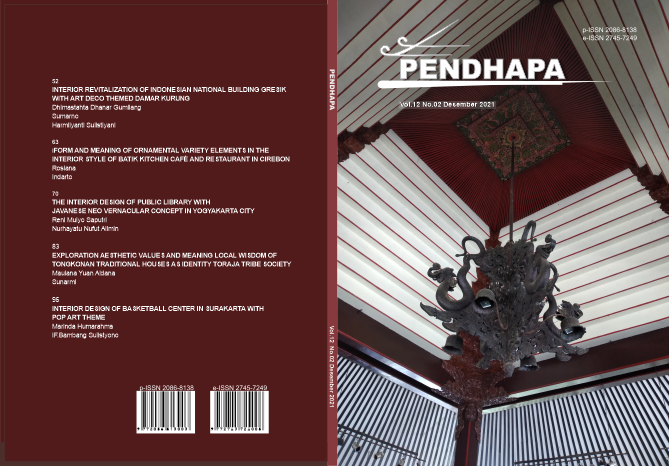Exploration Aesthetic Values and Meaning Local Wisdom of Tongkonan Traditional Houses as Identity Toraja Tribe Society
DOI:
https://doi.org/10.33153/pendhapa.v12i2.4042Keywords:
Aesthetics, Value and Meaning, Local Wisdom, Toraja, Tongkonan HouseAbstract
The traditional Toraja house known as Tongkonan is a work of aesthetic expression and architectural image of the Toraja tribe that has the value and meaning of local wisdom in its architectural design. This study aims to further study the Tongkonan house and explore the aesthetic value and meaning of local wisdom contained in the Tongkonan traditional house as the identity of the Toraja tribal community. With qualitative research methods and data collection techniques using library studies from several sources of documents or literature related to the research topic, it can be seen if visually, the architectural design construction of the Toraja traditional house (Tongkonan) consists of the legs formed by wooden poles, the body part which contains the spaces that are lined up and the upper part is a roof made of bamboo which is divided into two and arranged overlapping each other. Each of its components is considered to have visual and ritual elements that have symbolic meaning, both in the form of the Tongkonan itself as a whole and in its complementary visual elements. From the results of this study, it can be concluded that the Tongkonan house is not only a residence for the Toraja people, but in it there are various functions and meanings that cover all aspects from belief to life which become an identity for the Toraja people themselves. both in the form of Tongkonan itself as a whole and in the complementary visual elements. From the results of this study, it can be concluded that the Tongkonan house is not only a residence for the Toraja people, but in it there are various functions and meanings that cover all aspects from belief to life which become an identity for the Toraja people themselves. both in the form of Tongkonan itself as a whole and in the complementary visual elements. From the results of this study, it can be concluded that the Tongkonan house is not only a residence for the Toraja people, but in it there are various functions and meanings that cover all aspects from belief to life which become an identity for the Toraja people themselves.
Downloads
References
Arrang, Grilyon Tumba’, and Andi Agustang. 2020. “Pergeseran Pemaknaan Rumah Ada Tongkonan Dan Alang Pada Masyarakat Toraja.” Phinisi Integration Review 3 (2): 150. https://doi.org/10.26858/pir.v3i2.14416.
Aziz, Said Abdul. 2004. “Toraja: Simbolisme Unsur Visual Rumah Tradisional.” Yogyakarta: Ombak.
Fenn, Richard, and Clifford Geertz. 1974. “The Interpretation of Cultures.” Journal for the Scientific Study of Religion 13 (2): 248. https://doi.org/10.2307/1384392.
Haripoza, Okki Dwi. 2016. “Identifikasi Perubahan Arsitektur Rumah Tradisional, Studi Kasus Permukiman Desa Kurau, Aliran Sungai Desa Kurau Di Kabupaten Bangka Tengah, Provinsi Bangka Belitung.” Tesis Program Studi Magister Arsitektur Program Pascasarjana Universitas ….
Kobong, Theodorus. 2008. Injil Dan Tongkonan: Inkarnasi, Kontekstualisasi, Transformasi. BPK Gunung Mulia.
Meutia, Zya Dyena, and Zardan Araby. 2020. “Identifikasi Struktur Dan Ornamen Bangunan Masjid Tradisional Tuha Ulee Kareng Aceh Sebagai Kearifan Lokal.” EMARA: Indonesian Journal of Architecture 6 (1): 31–39. https://doi.org/10.29080/eija.v6i1.806.
Pakan, Marcelina Sanda Lebang, Maria Heny Pratiknjo, and Welly E Mamosey. 2019. “Rumah Adat ‘Tongkonan’ Orang Toraja Kabupaten Tana Toraja Propinsi Sulawesi Selatan.” HOLISTIK, Journal Of Social and Culture.
Patriani, Sepbianti Rangga. 2019. “Perubahan Visual Desain Arsitektur Rumah Adat Toraja.” GESTALT 1 (1): 113–24. https://doi.org/10.33005/gestalt.v1i1.25.
Rahayu, Weni. 2017. Tongkonan: Mahakarya Arsitektur Tradisional Suku Toraja. Kementerian Pendidikan dan Kebudayaan, Badan Pengembangan dan Pembinaan Bahasa.
Sir, Mohammad Mochsen. 2015. “Pengetahuan Tektonika Arsitektur Tongkonan.” In Seminar Nasional Dan Lokakarya Nasional Pemahaman Sejarah Arsitektur (LNPSA) XI.
Sitokdana, Melkior N.N, Radius Tanone, and Penidas Fiodinggo Tanaem. 2019. “Android-Based Digitalization of Number System of Traditional, Ngalum, Ketengban, Lepki and Arimtap Tribes.” Procedia Computer Science 161: 41–48. https://doi.org/10.1016/j.procs.2019.11.097.
Stephany, Shandra. 2009. “Transformasi Tatanan Ruang Dan Bentuk Pada Interior Tongkonan Di Tana Toraja Sulawesi Selatan.” Dimensi Interior 7 (1): 28–39.
Sunarmi. 2021. “Exploration of Javanese Local Wisdom for the Development of Archipelago Aesthetics Interior Design in the 4.0 Industrial Revolution Era.” Design Engineering, no. SE-Articles (December): 2153–65. http://www.thedesignengineering.com/index.php/DE/article/view/7158.
Sunarmi, Sunarmi, Kusmadi Kusmadi, and Sumarno Sumarno. 2017. “The Interpretation of Seat Facility’s Form and Funcion in Karmawibhangga Relief of Borobudur Temple.” In Proceeding of International Conference on Art, Language, and Culture, 414–25. Program Studi S2 Pendidikan Seni Pascasarjana Universitas Sebelas Maret Surakarta.
Tondi, Muhammad Lufika, and Sakura Yulia Iryani. 2018. “Nilai Dan Makna Kearifan Lokal Rumah Tradisional Limas Palembang Sebagai Kriteria Masyarakat Melayu.” LANGKAU BETANG: JURNAL ARSITEKTUR 5 (1): 15. https://doi.org/10.26418/lantang.v5i1.25383.
Downloads
Published
Issue
Section
License
Authors who publish with Pendhapa agree to the following terms:
- Authors retain copyright and grant the journal right of first publication with the work simultaneously licensed under a Creative Commons Attribution License (CC BY-SA 4.0) that allows others to share the work with an acknowledgment of the work's authorship and initial publication in this journal.
- Authors are able to enter into separate, additional contractual arrangements for the non-exclusive distribution of the journal's published version of the work (e.g., post it to an institutional repository or publish it in a book), with an acknowledgment of its initial publication in this journal.
- Authors are permitted and encouraged to post their work online (e.g., in institutional repositories or on their website) prior to and during the submission process, as it can lead to productive exchanges, as well as earlier and greater citation of published work.

This work is licensed under a Creative Commons Attribution-ShareAlike 4.0 International License.









